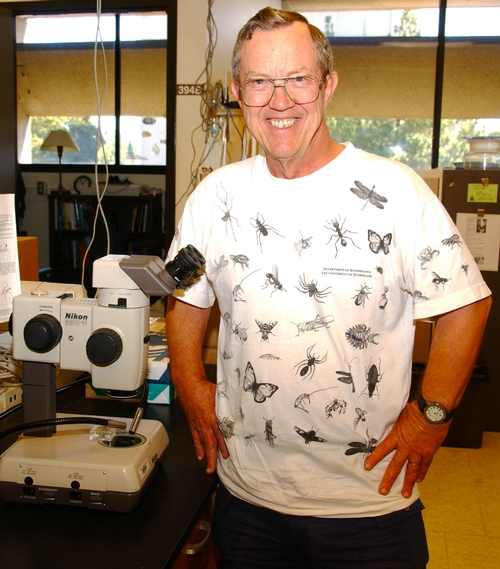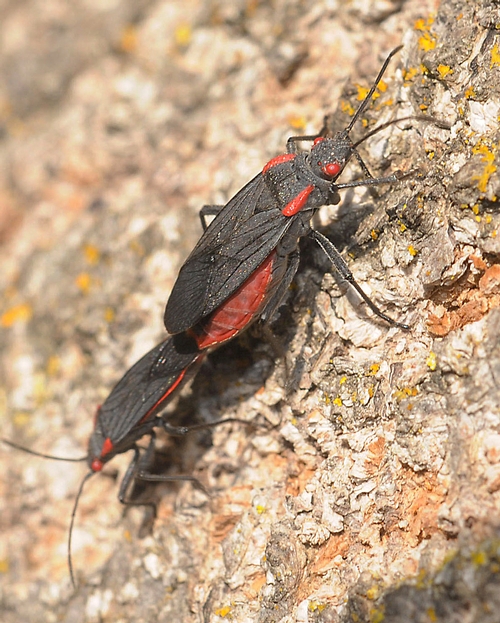- Author: Kathy Keatley Garvey

"Her" is aquatic entomologist Sharon Lawler of the UC Davis Department of Entomology and Nematology, now a professor emerita.
Lawler retired in January after a 28-year career at UC Davis, but was cleaning out her office and lab recently and took time to answer a few questions.
She is known as a “A dedicated teacher and mentor, an aquatic insect expert, a role model, and a compassionate human being.”
Although an emerita, she's still mentoring students and doing research.
“Sharon always put the needs of students first,” said longtime colleague, UC Distinguished Professor Richard “Rick” Karban, a community ecologist in the Department of Entomology and Nematology. “She was focused on what they needed from her rather than the other way around. In the department, she did more than her fair share of student-centric tasks. She was committed to accommodating and including the diverse circumstances of students before that was on many people's radars. Co-teaching community ecology with Sharon for 28 years, I learned a lot about science and even more about how to treat other people with compassion.”
“One incident that stands out for me,” Karban recalled, “is a time that we were walking back to Briggs Hall from teaching on the east side of campus. “Near the Memorial Union, we saw someone who was having a bad trip. He was yelling, waving his arms, and stumbling around. My reaction was to get away from the guy in case he was dangerous. Instead, Sharon went over to him to see if she could help. She stayed and talked with him to make sure he was okay.”
Richard Kim, a doctoral candidate whom she co-advises (with Professor Marissa Baskett, Department of Environmental Science and Policy), describes Lawler as “an amazing researcher and an outstanding role-model as a supervisor; joining her lab was one of the best decisions I've made in life.”
Kim, who holds a master's degree in biology from San Francisco State University (2017), commented: “Sharon has been advising my projects related to predator-prey relationships between the imperiled giant garter snakes and non-native bullfrogs: (1) experimental feeding trials and (2) mark-recapture surveying in the field. We are currently working to prepare manuscripts that will inform conservation strategies for the snakes by alternative controlling strategies for bullfrogs. Throughout my graduate school experience, Sharon provided not only academic guidance but also sincere advice and support during my personal and health difficulties. She truly is one of the role models I have in life, as a scientist and as a P.I. (principal investigator).
See the UC Davis Department of Entomology and Nematology feature story here and more images.
Nematologist Shahid Siddique, associate professor, UC Davis Department of Entomology and Nematology, wrote in the comments: "Sharon's retirement marks the end of an era for our Entomology and Nematology Department. Not only has she been an outstanding colleague, but also a dear friend to many of us. Sharon's compassion and willingness to help have always stood out. When I joined the department during the challenging times of COVID-19, it was Sharon who ensured I was settling in well. Her invaluable assistance played a very important role in helping me establish myself in Davis. We will deeply miss her presence, but her legacy of kindness and support will undoubtedly live on. Wishing Sharon all the best in her well-deserved retirement."
Thank you, Professor Emerita Sharon Lawler!
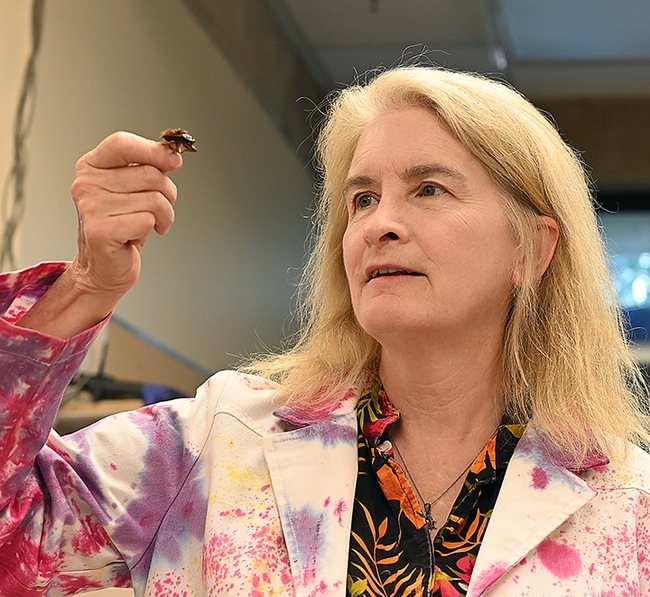
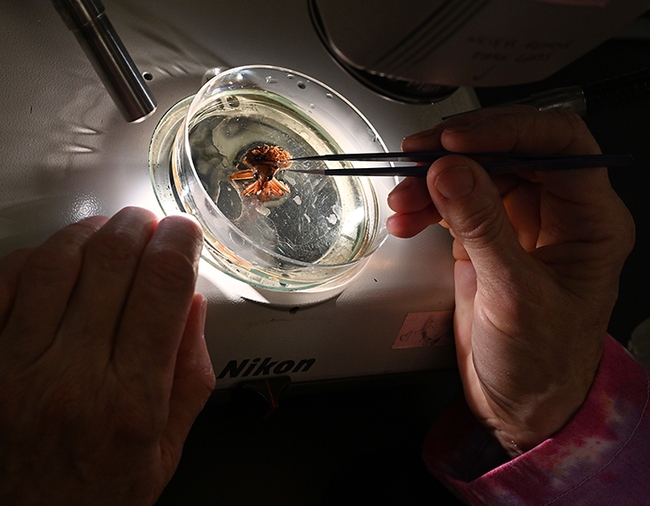
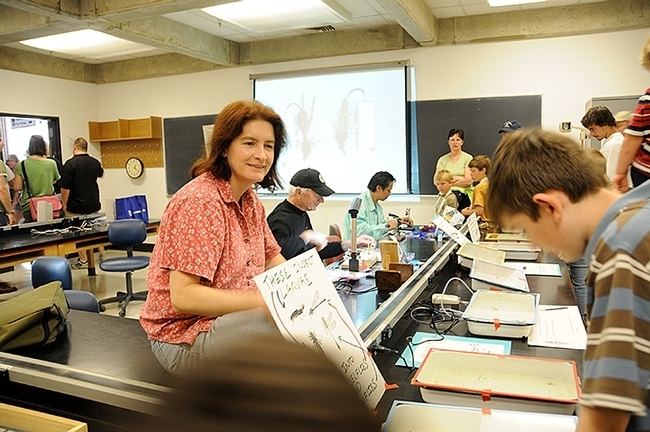
- Author: Kathy Keatley Garvey
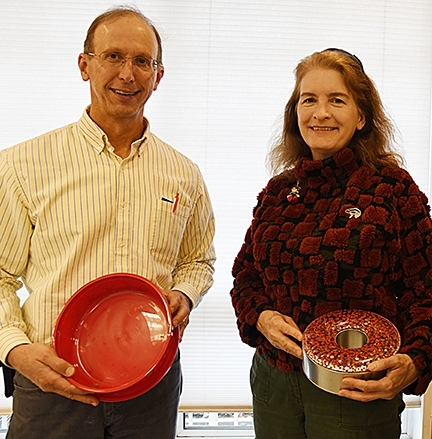
Sounds like a great story, right?
Make that great cookies.
They weren't there to present their research on nematodes, aquatic insects or pollinators. They were there to enjoy some camaraderie at the UC Davis Department of Entomology and Nematology's holiday party, and...drum roll...they won the top prizes in the cookie contest.
- Best chocolate cookie: Aquatic entomologist Sharon Lawler, professor, UC Davis Department of Entomology and Nematology, for her recipe, "Dirty Drunk Snowballs"
- Best non-chocolate cookie: Nematologist Steve Nadler, professor and chair, UC Davis Department of Entomology and Nematology, for his Internet-modified recipe, "Cranberry Orange Cookies"
- Best decorated cookie: Community ecologist Rachel Vannette, assistant professor, UC Davis Department of Entomology and Nematology, for her "Stamped Citrus Shortbread" recipe from the New York Times
William Tuck, academic personnel specialist in the Phoenix Cluster, which serves the Department of Entomology and Nematology and the Department of Plant Pathology, coordinated the event and awarded $25 Amazon gift cards to the winners.
The proof of the pudding? Empty containers.
Want to make the recipes? They shared!
Dirty Drunk Snowballs
By Sharon Lawler
Ingredients:
1 box Trader Joe's Mini Dark Chocolate Mint Stars
1/4 cup dark rum (white rum or bourbon will also work)
1/4 cup confectioner's sugar
Method:
Grind up the cookies in a food processor or blender until pretty fine but with some texture left. Stir enough dark rum so that the crumbs hold together well, but stop before it gets soggy. Let the mix sit for 15 minutes or so. Sift the confectioner's sugar into a bowl. Roll the mix into small balls, and then roll them in the confectioner's sugar.
Cranberry Orange Cookies
By Steve Nadler
Internet-modified recipe
Ingredients:
1 cup unsalted butter, softened
1 cup granular white sugar
1/2 cup brown sugar (packed)
1 egg
1-1/2 teaspoons grated orange zest
5 tablespoons orange juice
2-1/2 cups all-purpose flour
1/2 teaspoon baking soda
1/2 teaspoon salt
2 cups orange-flavored dried cranberries (Trader Joe's)
1-1/2 cups confectioner's sugar
Method:
- Use a food processor to chop the dried cranberries
- Preheat oven to 375 degrees F.
- In a large bowl, blend together the butter, white granular sugar, and brown sugar until smooth.
- Whisk the egg in a small bowl, then mix into the large bowl.
- Add 1 teaspoon of orange zest and 2 tablespoons of orange juice into the large bowl and mix.
- In a separate bowl, mix together the flour, baking soda, and salt.
- Stir the flour mixture from step 6 into the large bowl.
- Mix in the chopped cranberries, working to distribute them evenly.
- Drop cookie dough mixture (rounded tablespoon) on ungreased cookie sheets. Space them 2 inches apart.
- Bake for about 12 minutes in the preheated oven (375 F). The edges will begin to turn golden brown when ready.
- Remove cookies from sheets and cool on wire racks.
- In bowl, mix 1/2 teaspoon orange zest, 3 tablespoons of orange juice, and the confectioner's sugar until smooth. Brush on the tops of the cooled cookies. Let dry.

By Rachel Vannette
Recipe from New York Times
For the Cookies
- 2 cups/255 grams all-purpose flour, plus more as needed
- ⅓ cup/45 grams cornstarch
- ½ teaspoon kosher salt
- 1 cup/225 grams unsalted butter (2 sticks), softened
- ½ cup/100 grams granulated sugar
- 1 orange (preferably tangelo)
- 1 lemon
- ½ teaspoon vanilla extract
- ½ teaspoon lemon extract
- ¾ cup/75 grams sifted confectioners' sugar
- 1 tablespoon melted butter
- 1 tablespoon fresh orange juice, plus more as needed
For the Glaze:
- 3/4 cup/75 grams sifted confectioners' sugar
- 1 tablespoon melted butter
- 1 tablespoon fresh orange juice, plus more as needed
Preparation
- Prepare the cookies: Add flour, cornstarch and salt to a medium bowl, and whisk to combine. Set aside.
- Combine butter and granulated sugar in the bowl of a stand mixer fitted with the paddle attachment. Zest half the orange and half the lemon directly into the bowl. Reserve the lemon and orange for the glaze. Cream the butter mixture on medium-high speed until light and fluffy, 2 to 3 minutes. Add vanilla and lemon extracts and beat on medium speed until well combined, scraping the bowl a few times as needed.
- Add the flour mixture to the butter mixture and beat on low speed just until combined. Scrape the bowl and fold a few times to make sure everything is well combined. Wrap dough in plastic wrap, flatten into a disk, and chill until firm, at least 1 hour, and up to 3 days.
- Heat oven to 350 degrees. Cut dough in half and let one piece warm up for 30 minutes if it has chilled longer than an hour. Return the other half to the refrigerator. Portion the dough into pieces roughly the size of walnuts (a scant 2 tablespoons/about 35 grams), then roll each piece into a ball between your hands. One at a time, dip a ball of dough into flour and set on work surface. If dough balls soften too much, return them to the refrigerator to firm up for a few minutes. You want it cool, but malleable. Dip cookie stamp in flour, and press down on the ball of dough until it is about 1/4-inch thick. Remove stamp. (If dough sticks to stamp, carefully peel it off. Don't worry about excess flour as you will brush it off after chilling.) Trim the edges using a 2-inch cookie cutter, and transfer dough rounds to 2 parchment- or silicone mat-lined baking sheets, arranging them about 1 1/2 inches apart. Repeat with remaining dough.
- Once you have stamped out all the cookies, knead together the scraps to make a few more. Chill in the freezer until very firm, about 10 minutes. When cold, brush off any excess flour with a dry pastry brush.
- Bake until cookies just start to turn golden underneath, 12 to 14 minutes, switching the baking sheets from front to back and top to bottom halfway through baking time.
- Make the glaze while the cookies bake: Zest the remaining skin from the reserved lemon and orange into a small bowl. Add the confectioners' sugar, butter and orange juice and whisk until smooth. If glaze is too thick, add more orange juice. If it is too thin, add more confectioners' sugar. It should be the consistency of thin custard.
- Let the cookies cool for a few minutes on the baking sheets, and transfer to a wire rack set over a parchment- or wax paper-lined baking sheet. Pick up a cookie, and using the back of a small spoon, spread a generous teaspoon of glaze on a cookie, letting any excess drip onto the next cookie. Repeat until all the cookies are glazed. Cool completely. Cookies will keep in an airtight container at room temperature for up to 1 week.
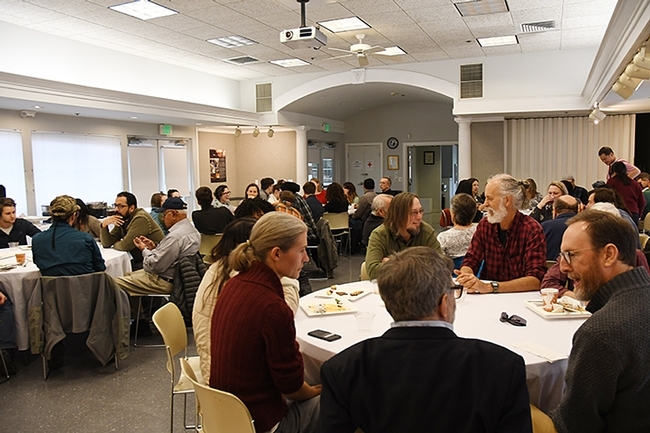
- Author: Kathy Keatley Garvey

The annual UC Davis Research Symposium on the Designated Emphasis in the Biology of Vector-Borne Diseases (DEBVPD) takes place from 3 to 8 p.m., Thursday, May 3 in the Putah Creek Lodge, and will feature two speakers and a graduate student poster session.
Addressing the gathering will be speakers Lark Coffey, member of the Department of Pathology, Microbiology and Immunology in the UC Davis School of Veterinary Medicine, and research director Stéphane Blanc of the program, Biology and Genetics of Plant-Pathogen Interactions at the Institut National de la Recherche Agronomique (INRA) in Montpellier, France.
The event begins with opening remarks at 3:10, followed by Coffey's presentation at 3:20 on “Contrasting Virulence and Transmissibility in Disparate hosts: A Zika Virus Mutation that Associates with Fetal Death in Rhesus Macaques Reduces Transmission by Aedes aegypti Mosquitoes.”
The graduate student poster session begins at 4:05 p.m., with Laura Backus, Nicholas Booster, Marisa Donnelly, Jessica Franco, Karen Holcomb, William Louie, Risa Pesapane, Benjamin Plourde, Maribel Portilla, Jennifer Reed, Kasen Riemersma, Pascale Stiles and Olivia Winokur presenting.Blanc's address follows at 5:30 p.m. on "Current Research Trends in the Interaction between Plant Viruses and Insect Vectors."

Coffey focuses her research on the ecology and evolution of arthropod-borne viruses, including Zika, West Nile and Chikungunya. They are significant causes of human disease, with no vaccines or treatments beyond palliative care.
Her team seeks to understand patterns of viral molecular evolution in enzootic and epidemic settings and the viral genetic factors that promote emergence of epidemic variants via host range changes. Studies also focus on how intrahost arboviral genetic diversity generated by error-prone viral replication to produce minority variants influences infectivity and transmissibility in mosquito and vertebrate hosts. The team is also developing approaches to improve arbovirus surveillance.
Coffey received her bachelor's degree in biology at the University of the South, Sewanee, Tenn., and her doctorate in experimental pathology from the University of Texas Medical Branch in Galveston, Texas. She then conducted research at the Institut Pastuer in Paris, France, and at the University of San Francisco.
Blanc has been with INRA Montpellier since 1997 and with his current research unit since 2004. He studies interactions among viruses, insect vectors and plant hosts. His group works at multiple scales from molecular to viral genetics and population dynamics. In addition, he has an innovative focus on understanding multipartite viruses.
He received his undergraduate degree in biology of populations and organisms from the University of Montpellier. His doctoral research, also at the University of Montpellier, addressed molecular mechanisms of plant virus transmission by insect vectors. After receiving his doctorate in 1993, he studied plant virus vector-transmission at the University of Kentucky, Lexington, with Professor T. P. Pirone.
For more information on the symposium, contact Lawler at splawler@ucdavis.edu. For information on dinner reservations, access https://bit.ly/2HanMrt.
The Department of Entomology and Nematology and the Department of Plant Pathology are home to the Designated Emphasis in the Biology of Vector-borne Diseases (DEBVBD).
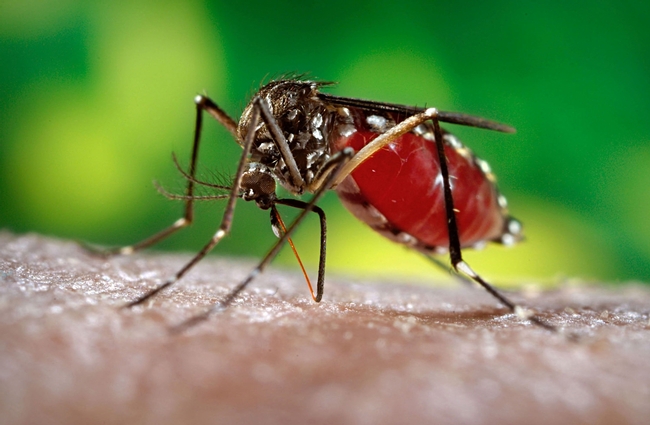
- Author: Kathy Keatley Garvey
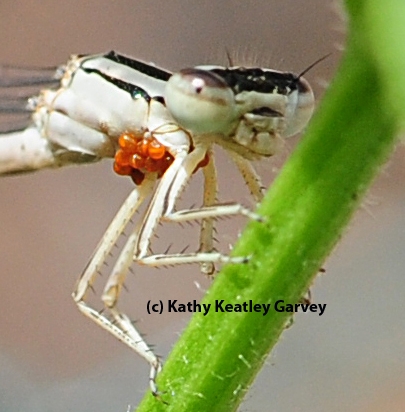
A pond attracts dragonflies and damselflies.
Last weekend, though, we spotted a damselfly a good 65 feet away from our pond. It touched down on our passion flower vine (Passiflora). Lights, camera, action...
The enlarged photo revealed a surprise: a cluster of something reddish-orange beneath the thorax.
Now that's something you don't see every day!
"Water mites," said native pollinator specialist Robbin Thorp, emeritus professor of entomology at UC Davis. (There are also images on BugGuide.net.)
"Phoresy," said entomology graduate student Lesle Saul-Gershenz, and professor Sharon Lawler, both of the UC Davis Department of Entomology and Nematology. Phoresy is a symbiotic relationship in which one organism transports another organism of a different species. Bottom line: these bright red mites, from the tick family, are hitchhikers that feed on body fluids. They jump off when the host drops down over a new pond or wetland.
What's the effect of water mites on damselflies? Surely, that parasitic load of arachnid hitchhikers must be cumbersome.
Scientists Jose Andres and Adolfo Cordero of the Universidade de Vigo, Pontevedra, Spain, took a close look at parasitism in their research “Effect of Water Mites on the Damselfly, Ceriagrion tenellum,” published in a 2002 edition of Ecological Entomology.
They pointed out:
1. "Water mite parasitism is expected to have an important effect on damselfly survivorship and reproductive success, because mites drain considerable amounts of body fluids from their hosts," they wrote in their abstract. "This study tests the effect of water mite parasitism in a marked population of the damselfly Ceriagrion tenellum during 1995 (individuals marked as mature adults) and 1996 (individuals marked as tenerals)."
2. "Almost all teneral individuals were parasitized (98%) and mites were aggregated strongly on some individuals. Parasite load increased during the season."
3. "Parasites had no effect on the probability of recapture of hosts as mature adults. The average daily survival rate of lightly- and heavily-parasitized individuals, estimated with Jolly's stochastic method, did not differ significantly."
4. "In 1995 parasites had a significant effect on host mating success. The probability of mating was about 25% lower for heavily parasitized males than for lightly parasitized males. Lightly parasitized males also mated more times than heavily parasitized males, even if heavily parasitized males lived longer. In 1996, parasitism did not have an effect on male mating success. In both years mites had no effect on female lifetime mating success."
In conclusion, they found that "water mite parasitism does not reduce damselfly survivorship, but it could reduce male mating success in some circumstances. Further long-term studies are needed, especially in populations with a lower incidence of parasitism."
As for our little damselfly, it lumbered away with its distinctive load of little red hitchhikers clinging to its thorax...
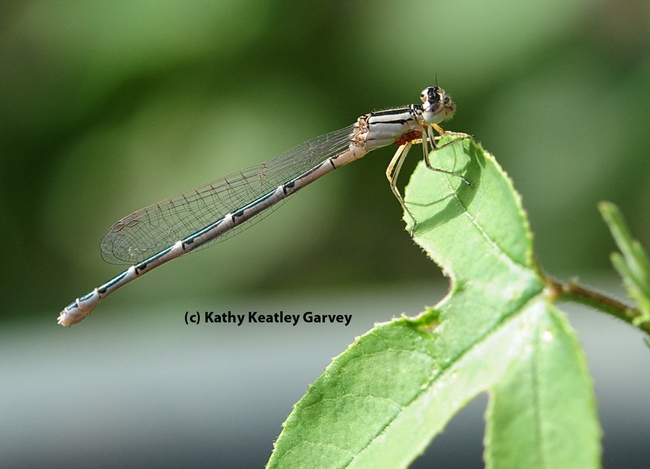
- Author: Kathy Keatley Garvey
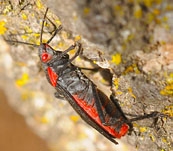
That would be "the rapidly evolving soapberry bugs."
Hugh Dingle, emeritus professor of entomology at UC Davis, will present a UC Davis Department of Entomology seminar from 12:10 to 1 p.m. on Wednesday, Nov. 10 in 122 Briggs Hall.
His topic: "And the Beak Shall Inherit: Contemporary Local and Reverse Evolution in Morphology and Life History in American and Australian Soapberry Bugs."
Professor Sharon Lawler of the Department of Entomology faculty will introduce him.
Dingle's lecture will be webcast live, and then will be archived on the UC Davis Department of Entomology website.
During his 20-year tenure on the UC Davis faculty, Dingle studied various aspects of insect migration “and especially the relation between migration and the evolution of life histories.”
“One aspect of these studies,” he said, “was the rapid contemporary evolution of insects (soapberry bugs) on introduced host plants (golden rain trees), including the interesting genetic relationships between feeding habits and variation in the ability to fly and migrate.”
His seminar will focus on laboratory-selection experiments on North American soapberry bugs designed to assess the genetic relationships among rapidly evolving traits, including the feeding apparatus and the structure and function of wings and wing muscles, necessary to migratory behavior.
“The bugs respond rapidly to selection for both forward and reverse evolution, demonstrating that the genetic variation necessary for evolution is present in the bugs even after intense natural selection,” Dingle said.
Of particular interest is a genetic correlation between mouthpart structure and wing morph frequency so the two traits share genes and evolve together. “The ecology of the bugs reveals why this might be the case,” he said. “A similar rapidly evolving soapberry bug system exists in Australia allowing intercontinental comparisons of contemporary evolution in these bugs as a consequence of the introduction of exotic host plants.”
For the last seven years, Dingle has been living and doing research at the University of Queensland, Brisbane, Australia. Now a resident of Davis, he is continuing his research from his headquarters in the Lawler lab.
Dingle received his bachelor's degree in zoology, with honors, from Cornell University, and his master's and doctorate degrees in zoology from the University of Michigan.
Meanwhile, be sure to check out UC Davis researcher Scott Carroll's website on soapberry bugs. Carroll, also associated with the Lawler lab, maintains a Flickr site and invites images of soapberry bugs.
Evolution in action...
